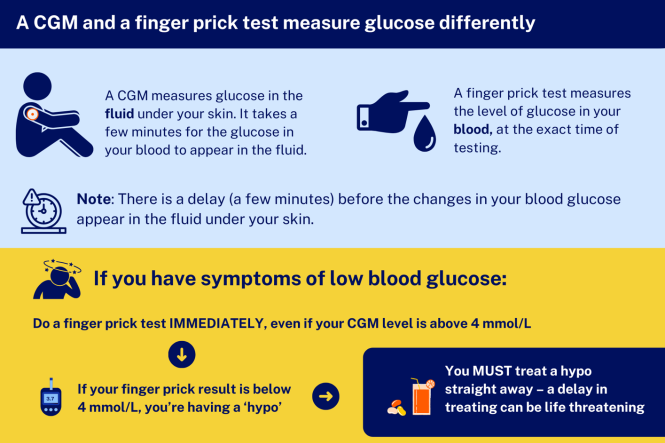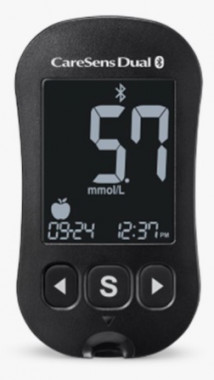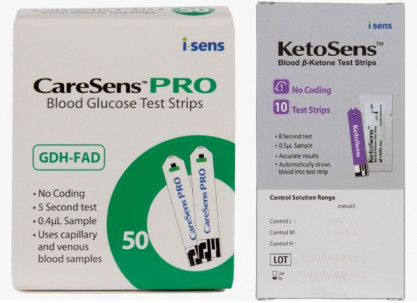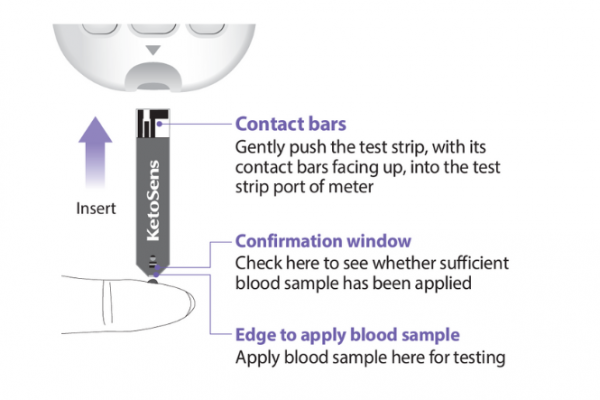Wishing everyone happy holidays and a joyful New Year from the Healthify team. Don't forget to Slip, Slop, Slap and Wrap!
Dual blood glucose and ketone test meters
Key points about dual blood glucose and blood ketone test meters
- A dual blood glucose and blood ketone test meter allows you to test for blood glucose as well as blood ketones using a single meter.
- These meters are funded for people who meet specific criteria.
- Learn more about blood glucose and blood ketone diagnostic test meters.

A dual blood glucose and blood ketone test meter allows you to test for blood glucose as well as blood ketones using a single meter. You will need to use different test strips depending on whether you're measuring glucose or ketones.
- Once you've pricked your fingertip with a lancet, a small drop of blood is applied to the narrow edge of a test strip. The strip automatically absorbs the blood. This is called a finger prick test.
- Depending on which test strip you use (glucose or ketone strip), it's inserted into the test meter which then measures your blood glucose or ketone level.
- The reading on the meter shows the levels in your blood at the time you prick your finger.
You may want to use it even if you're using a continuous glucose monitor (CGM), to monitor blood glucose and ketones.
Read more below about when a dual blood glucose and blood ketone test meter is used.
To monitor your blood glucose, if you are not using a continuous glucose monitor (CGM)
Generally people with type 1 diabetes should test every time they give themselves quick acting insulin, so the dose can be adjusted if their blood glucose is high. They may also need to measure blood glucose levels before meals and before bedtime.
Testing your blood glucose helps you to:
- monitor your blood glucose to make sure that the amount of insulin you're getting is just right for you
- look for high or low glucose levels so they can be treated if needed
- monitor and treat diabetes during exercise and illness.
Learn more about blood glucose testing for type 1 diabetes.
To check your blood glucose, if you are using a CGM
Finger prick tests are still important even if you're using a CGM to monitor your glucose levels. That's because finger prick tests give a more accurate reading of your blood glucose.
You should still check your blood glucose level using a finger prick test when you are sick, and if:
- You have symptoms of low blood glucose but your CGM reads above 4 mmol/L: If the blood glucose level on your finger prick test is below 4 mmol/L, you're having a hypo and must treat it immediately. Read more about how to treat hypoglycaemia (low blood glucose).(external link)
- Your CGM reads below 4 mmol/L but you don't have symptoms of low blood glucose: Only treat yourself for a hypo if your blood glucose level on your finger prick test is below 4 mmol/L.

Image credit: Healthify He Puna Waiora
To monitor your blood ketones
- Your body makes ketones when it’s using fat instead of glucose for energy. This usually happens when your body doesn't have enough insulin(external link) to help it use glucose for energy. Instead, your body starts burning fat for energy, which releases harmful ketones.
- A build-up of ketones in your body causes your blood to become acidic. This is why it's called ketoacidosis.
- Monitoring blood ketones allows you to find out early if you are developing diabetic ketoacidosis.
- Diabetic ketoacidosis can become life threatening very quickly. It's important to know when to test for ketones and what to do if your ketones are raised.
Learn more about diabetic ketoacidosis.
In Aotearoa New Zealand dual blood glucose and ketone meters are subsidised for people who have:
- type 1 diabetes
- permanent neonatal diabetes
- had a pancreatectomy (operation to remove the pancreas)
- cystic fibrosis-related diabetes
- metabolic disease or epilepsy under the care of a paediatrician, neurologist or metabolic specialist.
These criteria can change, so check with your diabetes nurse or doctor.
The funded dual blood glucose and blood ketone test meter is the CareSens Dual meter.

Image credit: Pharmaco(external link) (with permission)
Compatible test strips
You'll need to use different test strips depending on whether you're measuring glucose or ketones.
- Glucose testing strips: CareSens PRO
- Ketone testing strips: KetoSens

Image credit: Pharmaco(external link) (with permission)
If you're not sure how to use your blood glucose meter, your healthcare provider can teach you. This could be a diabetes nurse educator or diabetes nurse specialist, your local pharmacist or a nurse at your GP surgery. Some cities have a representative from the company supplying your meter and they will be able to teach you if they're available.
Here is some guidance:
- Gently push a test strip, with its contact bars facing up, into the test strip port at the bottom of the meter. This will turn the meter on.
- Prick your finger and touch the dot of blood with the narrow edge of the strip. Blood will be drawn up into the test strip.
- The display on the meter will show either the number 5 (with blood glucose strips) or 8 (with ketone strips) and count down to 1, then the test result will be shown.

Image credit: Pharmaco(external link) (with permission)
You can watch videos on how to use the CareSens Dual. (external link)
Tips when using your test meter
- Make sure your hands are clean: Wash and dry your hands and fingertips before testing. If you've been handling something sweet before testing, sugar may get onto your test strips or meter and make your reading falsely high.
- Pricking your finger: Prick your finger on the side (towards the tip) rather than on the pad or tip. This will be more comfortable for you afterwards, especially if you use a keyboard. You'll get a much better sized drop of blood if your hands are warm before testing.
- The lancets (prickers) that are used within the finger-pricking device should be changed at least every 2 or 3 days. This reduces pain and also reduces the risk of infection.
Travelling with diabetes
Information about travelling with diabetes can be found on the pages linked below.
- Diabetes and travelling(external link) Diabetes New Zealand
- Navigating airport security screening – guidance for people living with diabetes(external link) Aviation Security Service, NZ
- Travelling with children who have diabetes(external link) KidsHealth NZ
- Travel(external link) Diabetes Australia
- Travel and type 1 diabetes(external link) Diabetes Australia
Disposing of your diabetes supplies
You can put your used test strips in the general rubbish. Lancets (finger prickers) must be disposed of in a sharps bin. Read more about how to dispose of syringes, needles and other sharps safely.
References
- Dual blood glucose and blood ketone diagnostic test meter(external link) Pharmac Schedule, NZ
- Diagnostic and monitoring devices for diabetes mellitus(external link) New Zealand Formulary
Credits: Sandra Ponen, Pharmacist, Healthify He Puna Waiora. Healthify is brought to you by Health Navigator Charitable Trust.
Reviewed by: Claire Salter, Clinical Pharmacist, Tauranga; Angela Lambie, Pharmacist, Auckland
Last reviewed:





